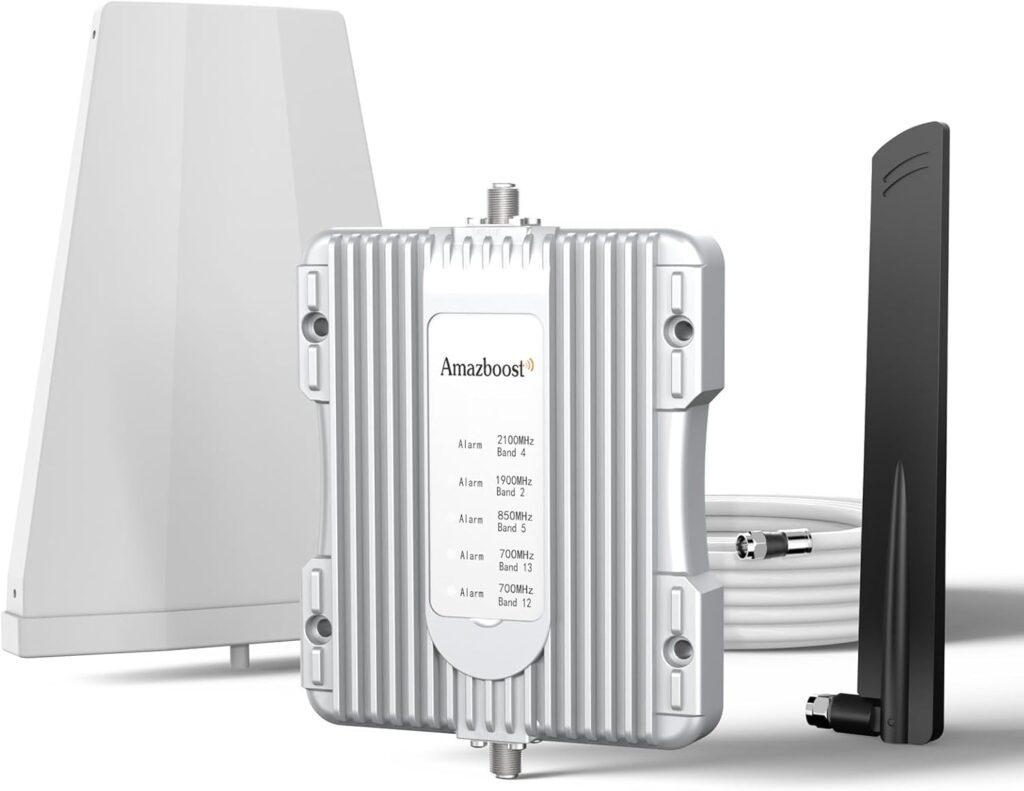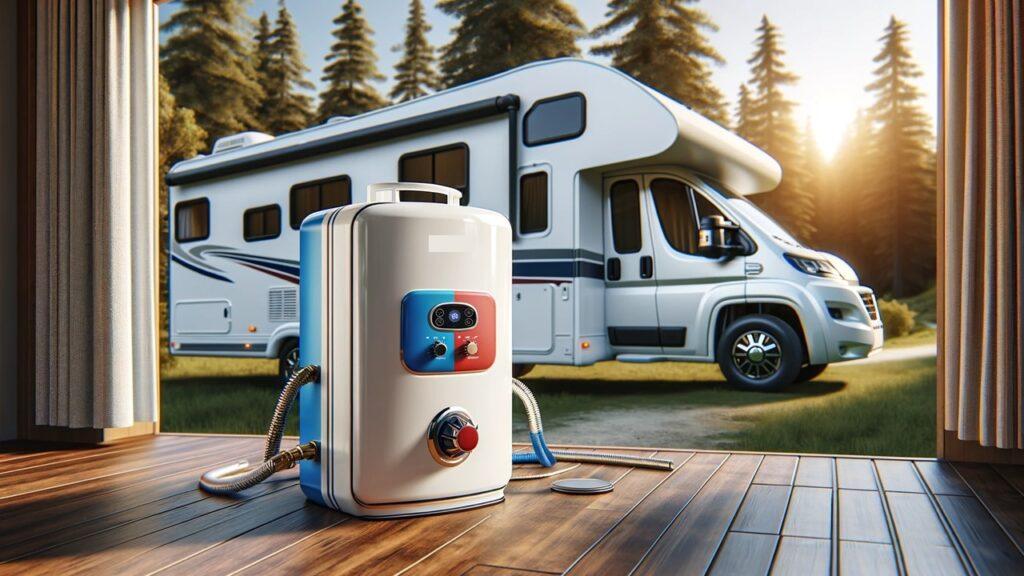Cell signal booster for your RV isn’t just an upgrade—it’s the key to staying connected in remote areas, ensuring clear calls, fast data, and uninterrupted navigation wherever you roam. In this article, we have researched and reviewed 5 of the best cell signal booster for RV in 2025 for you to pick.
We’re reader-supported. When you buy through links on our site, we may earn an affiliate commission. As an Amazon Associate, we earn from qualifying purchases.
Our Top 5 Picks of The Best Cell Signal Boosters for RV
- Overall Option: weBoost Drive Reach Overland
- Budget Option: Amazboost Cell Phone Booster
- Most Portable: HiBoost Travel 2.0 RV
- Tech Features Option: AplusBoost Cell Phone Booster for RV
- For Larger RVs: HiBoost Cell Phone Signal Booster for RV
What Is The Best Cell Signal Booster for RV In 2025?
The best cell signal booster for RVs in 2025 ensures strong, reliable connectivity on the road, reducing dropped calls and boosting data speeds for seamless navigation and communication. Here is our list that we have curated for you:
1. Overall Option: weBoost Drive Reach Overland

Key Features:
- Works with all U.S. carriers like Verizon, AT&T, and T-Mobile.
- 5G compatible for the fastest speeds and latest technology.
- Durable outdoor antenna with versatile mounting options.
- Easy DIY installation in just 30 minutes.
- FCC-approved with 50 dB max gain.
The weBoost Drive Reach Overland is my top pick for the best cell signal booster for RVs because it’s built for adventure. Whether you’re deep in the mountains or cruising through the desert, this booster keeps you connected with reliable calls, texts, and data. The rugged outdoor antenna holds up against extreme conditions, making it perfect for remote areas where weak signals are common.
The setup is straightforward, even for those who aren’t tech-savvy. I had mine installed in about half an hour, and it worked seamlessly with my Verizon plan. It’s compatible with all major carriers, which is great if you’re traveling with friends or family who use different providers. However, it’s not the cheapest option, so if you’re on a tighter budget, this might be a stretch.
That said, the performance is worth every penny. It handles long road trips and challenging terrain without dropping signals. From my experience, this is one of the top RV signal boosters for 2025, especially if you want reliability on the road.
Pros:
- Works with all U.S. carriers.
- Durable and weather-resistant for off-road adventures.
- Enhances 5G speeds for smoother internet use.
- Covers multiple devices at the same time.
- Easy installation with no professional help required.
Cons:
- A bit pricey compared to others.
- Slightly heavier than some portable options.
- May require fine-tuning for the best performance in very remote areas.
2. Budget Option: Amazboost Cell Phone Booster

Key Features:
- Affordable signal booster for RVs or homes.
- Covers up to 2,500 sq ft with detachable antenna.
- Compatible with 5G, 4G LTE, and 3G for all U.S. carriers.
- FCC-approved and comes with a 30-day money-back guarantee.
- Easy installation with no subscriptions or hidden fees.
The Amazboost Cell Phone Booster is an excellent affordable cell booster for RVs. While it’s marketed primarily for homes, it works well in RVs if you’re parked for long periods.
Its coverage is perfect for small spaces, and it’s compatible with all major U.S. carriers. I tested it in a cabin-style RV, and the improvement in call quality and internet speed was noticeable.
The downside is its limited range in very weak signal areas. You’ll need at least one bar outside for it to work effectively. Still, at this price point, it’s a great option for budget-conscious buyers.
Pros:
- Affordable and budget-friendly.
- Works well in small RVs or stationary setups.
- Compatible with all carriers and 5G.
- No subscription or extra fees.
- Easy to set up and use.
Cons:
- Limited range compared to premium models.
- Requires at least one bar of signal outside.
- Not ideal for large or mobile RVs.
3. Most Portable: HiBoost Travel 2.0 RV

Key Features:
- Compact design with weatherproof outdoor antenna.
- 50 dB max gain, compatible with 5G and 4G LTE.
- Works with all major U.S. carriers.
- Includes an app for monitoring signal strength.
- Flexible indoor antenna for easy placement.
The HiBoost Travel 2.0 is a perfect portable signal booster for RVs. Its compact size and lightweight design make it ideal for travelers who need something simple yet effective. The flexible indoor antenna is a game-changer; you can move it around your RV to find the best spot, whether you’re working on your laptop or streaming a movie in bed.
The app is handy, giving real-time updates on signal strength and making troubleshooting easy. However, the booster’s range is smaller than some of the heavy-duty models, so it’s best suited for smaller RVs or solo travelers. Still, it’s one of the best RV cell boosters for weak signals if you prioritize portability.
Pros:
- Compact and lightweight for easy travel.
- Flexible antenna placement for better customization.
- App provides real-time monitoring and support.
- Simple setup that doesn’t require professional help.
- Affordable compared to other boosters.
Cons:
- Smaller range than larger models.
- Best for smaller RVs or fewer users.
- May need occasional adjustments for optimal performance.
4. Tech Features Option: AplusBoost Cell Phone Booster for RV

Key Features:
- Real-time LCD display for monitoring signals.
- Boosts 5G and 4G LTE signals for all carriers.
- Comes with two indoor antennas for better coverage.
- Weather-resistant outdoor antenna for harsh environments.
- FCC-approved with 50 dB max gain.
The AplusBoost Cell Phone Booster stands out with its smart LCD display, making it easy to monitor and adjust signal settings.
This is a long-range signal booster for RVs, thanks to its upgraded outdoor antenna that pulls in signals from all directions. I found it particularly useful in remote areas where my other boosters struggled.
The dual indoor antennas are a nice touch, giving you flexibility in placement. However, the setup process is more involved, taking closer to an hour. If you’re tech-savvy or love gadgets, this is one of the top RV signal boosters for 2025.
Pros:
- Smart LCD for easy monitoring and adjustments.
- Dual indoor antennas for flexible coverage.
- Sturdy design handles extreme weather.
- Great for remote areas with weak signals.
- Supports multiple devices seamlessly.
Cons:
- Longer installation time.
- On the expensive side.
- Requires more effort to optimize performance.
5. For Larger RVs: HiBoost Cell Phone Signal Booster for RV

Key Features:
- Boosts 5G and 4G signals for all U.S. carriers.
- Omni-directional antenna for wide coverage.
- FCC-approved with 50 dB max gain.
- Designed for all RV types, including Class A, B, and C motorhomes.
- Lifetime technical support and a 3-year warranty.
If you have a big rig or travel trailer, the HiBoost RV 3.0 Booster Kit is a fantastic choice. It’s designed to handle larger vehicles, which means you’ll get strong signals even when your RV feels like a small house on wheels. The omni-directional antenna grabs signals from all directions, so there’s no need to aim it toward a cell tower.
I love that this booster is built tough. It handles harsh outdoor environments like rain and extreme heat, which is a huge plus for extended trips. The DIY installation took me about an hour, and the included video guide made it a breeze. On the downside, it’s bulkier than other options, so if space is tight, it might not be ideal.
This is a reliable RV signal amplifier for remote areas, especially for families or groups who need consistent connectivity across multiple devices.
Pros:
- Great for larger RVs and motorhomes.
- Omni-directional antenna eliminates the need for adjustments.
- Comes with a helpful installation video guide.
- Handles tough weather conditions.
- Supports multiple users and devices.
Cons:
- Takes longer to install compared to smaller units.
- Bulkier design might be a challenge for compact RVs.
- More expensive than basic models.
How We Tested the Products
As van lifers, we’ve had plenty of opportunities to try out some of these signal boosters firsthand. From camping in remote areas with barely a signal to navigating rugged terrain, we’ve tested how well they perform when it matters most. It’s easy to spot the ones that make a real difference when you rely on your phone for directions or staying connected.
We also leaned on feedback from friends and fellow RVers who’ve used these boosters in their own setups. Their experiences, whether in compact campervans or large motorhomes, gave us a broader perspective on what works in different scenarios.
To top it off, we read hundreds of online reviews from actual buyers. Combining our experience with theirs gave us a clear picture of which products are reliable, user-friendly, and worth your time.
Why You Need a Cell Signal Booster for RV
If you’ve ever tried to make a call or check GPS in a remote area, you know how frustrating weak signals can be. RVing often means exploring off-the-beaten-path locations, but those same spots usually come with poor cell reception.
That’s where a good RV signal amplifier for remote areas comes in handy—it takes a weak signal and strengthens it so you can stay connected.
From personal experience, losing signal in the middle of a long road trip can feel like being stranded on a digital island. A cell signal booster for RV and campervan keeps your connections stable, even in the most challenging locations.
Here are some of the benefits of using a signal booster for RV:
- Fewer dropped calls and better voice quality.
- Faster data speeds for streaming and internet use.
- Improved navigation and safety in remote areas.
- Multiple devices can connect at the same time.
- Works with all major U.S. carriers like Verizon, AT&T, and T-Mobile.
How to Choose the Best RV Signal Booster
Here’s how to choose the best cell signal booster for your RV:
- Pick one that’s compatible with all U.S. carriers.
- Look for 5G compatibility for future-proofing.
- Consider your RV size and signal needs.
- Check for durability and weather resistance.
- Choose one with easy installation options.
Compatibility with All U.S. Carriers
When picking an RV cell phone booster, make sure it works with all the major carriers, like Verizon, AT&T, T-Mobile, and US Cellular. This is particularly important if you’re traveling with a group or family where everyone might use a different network. Double-check the product specs for supported bands to avoid any surprises.
Look for 5G Compatibility
A signal booster that supports 5G is not just for tech enthusiasts—it’s about staying ahead of the game. Even if your area doesn’t have 5G yet, a compatible booster will work with 4G LTE now and be ready when 5G becomes more widely available. It’s a good way to avoid upgrading too soon.
Match the Booster to Your RV Size
The size of your RV makes a difference. A smaller campervan can get by with a portable signal booster for RVs that covers a limited range. For larger Class A motorhomes or travel trailers, you’ll need something more powerful with wider coverage. Always check the square footage the booster can handle before buying.
Prioritize Durability and Weather Resistance
If you spend a lot of time exploring rugged terrain or unpredictable weather, durability matters. Look for models with weatherproof outdoor antennas that can handle rain, wind, and dust. These features are especially handy for long-term use in remote areas.
Choose Easy-to-Install Options
Nobody wants a complicated setup. Pick a booster with straightforward installation instructions or kits. Many products come with mounting brackets, labeled cables, and even smartphone apps for guidance. DIY-friendly models save you the hassle of hiring a professional.
How to Install an RV Signal Booster
Here’s how to install a signal booster in your RV:
- Mount the outdoor antenna where it has a clear, unobstructed view.
- Position the indoor antenna near your main living or working area.
- Connect the antennas to the booster using the included cables.
- Power up the booster and test for even coverage.
Step 1: Mount the Outdoor Antenna
Choose a high spot on your RV’s roof or a sidewall where the antenna has a clear line of sight. Avoid placing it near metal obstructions, as these can interfere with the signal. Use the mounting brackets or poles included with your kit to secure the antenna tightly.
Step 2: Position the Indoor Antenna
Decide where you’ll use your devices the most—like near the dining table, sofa, or dashboard—and place the indoor antenna there. Keep it away from thick walls or cabinets that could block the signal. If your booster kit includes a flexible antenna, experiment with placement to find the best spot.
Step 3: Connect the Antennas to the Booster
Run the provided cables from the outdoor and indoor antennas to the booster. Make sure the cables are tightly connected to prevent signal loss. Keep the cables as straight as possible, avoiding sharp bends or kinks.
Step 4: Power Up and Test the System
Plug the booster into a power outlet and turn it on. Walk around your RV with your phone to check if the signal improves in all areas. If you find any weak spots, try repositioning the indoor antenna or adjusting the outdoor one slightly.
Common Mistakes When Buying an RV Signal Booster
Avoid these mistakes when shopping for an RV signal amplifier for remote areas:
- Buying a booster that doesn’t support your carrier.
- Skipping 5G compatibility when future-proofing matters.
- Choosing a model with insufficient range for your RV size.
- Overlooking weather resistance for outdoor use.
- Not checking reviews or customer feedback.
Maintenance Tips for Your RV Signal Booster
Keeping your RV signal booster in good shape is simple but important for consistent performance.
- Clean the outdoor antenna regularly: Dust, dirt, and even bird droppings can interfere with signal reception. Use a soft cloth and mild soap to clean it every few weeks, especially after off-road trips.
- Check connections and cables for wear: Over time, cables might fray or connections may loosen. Inspect them every few months to catch any potential issues early.
- Store the booster properly during non-use: If you’re parking your RV for the season, remove and store the booster in a dry, cool place to protect it from extreme temperatures and moisture.
- Recalibrate the system when needed: If you notice weaker signals than usual, reset the booster by unplugging and reconnecting it. This simple trick often resolves minor glitches.
- Follow firmware updates if applicable: Some boosters come with software updates that improve performance. Check the manual or manufacturer’s website for instructions on keeping your device current.
Final Words
Staying connected on the road is no longer just about convenience—it’s about safety, navigation, and keeping in touch with loved ones. A reliable cell signal booster for RV makes all the difference, whether you’re camping in remote areas or traveling across busy highways.
From our tests and research, we found the weBoost Drive Reach Overland to be the best overall option for its rugged design, strong performance, and compatibility with all carriers.
If you’re traveling in a larger RV, the HiBoost Cell Phone Signal Booster for RV is an excellent choice for wide coverage and durability.
For those looking for a budget-friendly option, the Amazboost Cell Phone Booster offers great value for small RVs or stationary use.
Each product we reviewed has its strengths, so choose based on your specific needs, whether it’s portability, affordability, or tech features. With any of these boosters, you’ll enjoy stronger signals and smoother trips, no matter where the road takes you.
FAQs
Can a cell phone booster improve internet speed in an RV?
Yes, a cell phone booster strengthens your cellular signal, which can lead to faster data speeds for internet use. However, performance depends on the outdoor signal strength and your carrier’s network.
Do I need a professional to install an RV signal booster?
Most signal boosters are designed for DIY installation and come with user-friendly guides. If you’re comfortable with basic tools, you can set it up yourself.
Are signal boosters compatible with all carriers?
Most high-quality boosters, like the ones reviewed here, work with all major U.S. carriers, including Verizon, AT&T, T-Mobile, and US Cellular. Always double-check compatibility before buying.
Can I use a home signal booster in my RV?
Some home boosters, like the Amazboost, can be used in an RV if you’re parked in a stationary location. However, they may not be as durable or effective for on-the-go use.
What’s the difference between a portable signal booster and a larger unit?
Portable boosters are lightweight and ideal for smaller RVs or campervans, while larger units offer wider coverage and stronger signals, making them better for bigger motorhomes or long-term travel.
As outdoor enthusiasts ourselves, we understand the significance of reliable gear that can withstand the elements and support you throughout your journey. We try to provide as much real life information with our guides and how tos to the readers as possible. Our honest and transparent reviews of essential outdoor gadgets and products are rooted in testing and experience. We take great satisfaction in offering unbiased evaluations, ensuring that you can make informed decisions when investing in outdoor gear. As an affiliate website, we may earn a small commission from some of the products we feature. However, rest assured that our opinions are not influenced by this, and your trust is always our top priority.



